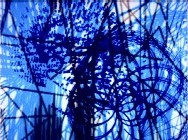
Kinetica 4, works of abstraction in film and video (December 2002 - 2004) presentations in Berkeley California, New York, Los Angeles County Museum, Harvard University Cambridge Mass., Toronto, Miami Florida, Cleveland Museum of Art Ohio, Seattle Washington, etc. http://www.iotacenter.org

"John"s spectacular film Cibernetik 5.3 combines computer graphics with organic live-action photography to create a new reality, a Third World Reality, that is both haunting and extraordinarily beautiful. Cybernetik makes use of realist imagery for its nonobjective qualities and thus impinges directly upon the emotions more successfully than any computer film discussed in this book. However, John considers the film only an "incidental test" in an ongoing experiment with computer graphics that has occupied most of his time for the last nine years. John is interested in addressing the computer directly through graphic images rather than using mathematics to achieve graphic images and thus becoming enmeshed in a "number game." Cybernetik is unique also in that it was constructed from semi-random image-generation techniques. Whereas most of the computer films discussed so far are characterized by mathematical precision, Cybernetik exudes a strong feeling for the uncontrolled, the uncontrollable, the unconceivable." Gene Youngblood, Expanded Cinema, 1969
Vintage Avanto 2 (Helsinki Media Arts Festival, November 6-11, 2001)
This screening fulfils the criteria of even the most demanding animation devotee.
John"s Cibernetik 5.3 is the 2001: A Space Odyssey of avant-garde film.
Its early vision of higher intelligence somewhere “out there” is
startling in its colorful splendor, and it may have been a direct influence
on the visual imagery of the metaphysical journey through time in Kubrick’s
classic. http://www.avantofestival.com/2001_screenings/fv_vintage.html
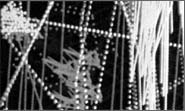 Cibernetik 5.3 - John~
Cibernetik 5.3 - John~
KOSMISCHE ARABESQUE (Brussels, May 22) De perfected geometrie
van de cirkel (mandala) is één van de vormen die verschijnt binnen
dit programma: van Belson's kosmologische visies tot Emshwiller's zonneschijf.
Van Fischinger naar de gebroeders Whitney, Belson, John, etc. Filosofieën
van Oosterse voorvaders en hun symbolische grafische uitdrukkingen en rituelen
gemengd met de impact van de wetenschap en het hedendaagse denken (van de relativiteitstheorie
tot cybernetica), poëzie met wereldlijk proza, en mathematica met de meditatiemachine
(yantra). Tenslotte beschreven Yin en Yang het binaire systeem reeds een lange,
lange tijd geleden. Cibernetik 5.3 (8 min.) John~, 1960-65, http://www.constantvzw.com/vj5/calCinProgN.html
Fachseminar, (Cologne Deutschland, June 7, 2000)
ScreenAge - Film als gestalterisches Medium (film as formative medium), http://mg.khm.de/screenage/veranstaltungen
A Short History of International Computer Animation, (Helsinki Finland, 1998)
MuuMediaFestival'98, the annual Nordic media arts festival, celebrates its
10th anniversary, October 9.-18.1998, in Helsinki at the Kiasma Museum of
Contemporary Art. http://www.av-arkki.fi/mmf/card/vs/16_1330.htm
The Whitney Museum of American Art - The American Century: Art & Culture 1900–2000 (New York, Sunday November 28, 1999) The Electronic Film and the Birth of Video Art Video Art -- Video art was born out of two strands of sixties American counterculture: the utopian desire for an expanded perception through new technology, and a rebellion against the institutional authority of mainstream television. At the inception of video in the mid-1960s, filmmakers and artists experimented with psychedelically inflected electronic image-processing techniques using audio and video synthesizers. A number of filmmakers incorporated the new electronic imagery of video into their filmmaking, creating "electronic" films. http://thecity.sfsu.edu/users/XFactor/fw/fw12/0995.html http://www.hi-beam.net/org/whitney/part1.html
CALCULATED CINEMA (Bruxelles Brussel, 2001) 16 TO 22 /05 /2001 FILM MUSEUM-
MUSEE DU CINEMA 16/05 + 17/05 20:15 18/05 to 22/05 22:15, Calculated Cinema
is a seven part series that focuses its attention on the pioneering use of
computers and electronics in experimental films. It looks at the creation
of new procedures in animation and, explores movement, light and synchronicity
between music and image, weaving a fabric of cross-references. These concerns
range from the first avant-garde groups, to examples in more recent work,
from
the binary geometry of calculated images to other arithmetical applications
based on stills, and other principles of systematic composition. http://amsterdam.nettime.org/Lists-Archives/nettime-l-0105/msg00091.html
The International Media Art Biennale, (Warsaw Poland, 1999) April 28th - May 2nd, 1999 Wroclaw, Poland, ABSOLUTE FILM, THE NEXT GENERATION, (Sunday May 2, 1999) http://www.wro.getin.pl/wro99/programme.html http://www.v2.nl/mail/v2east/1999/Apr/0339.html
Ö EL ARABESCO COSMICO (Cosmic Arabesques, Spain 1999) ZARAGOZA / SARAGOSSA, Filmoteca de Zaragoza, 5 al 15 de mayo, 1999; GRANADA / GRENADE, Palacio de los Condes de Gabia (Diputación de Granada) 20 al 29 de mayo, 1999; MADRID, Museo Nacional Centro de Arte Reina Sofía, 3 al 27 de junio, 1999; BARCELONA, Fundació Antoni Tàpies, 30 de junio al 11 de julio, 1999. http://thecity.sfsu.edu/users/XFactor/fw/fw11/0232.html
London Film and Video Programme (November 6-23,1997), Regus London Film Festival, in UK London & various cities. link: lff.org.uk Formerly The London Film Festival. The festival tours in about 13 cities around the UK after the London screenings.
European
Media Arts Festival, (Osnabrück Deutschland, September 6-10,
1995) Klassische Avantgarde und Historischer Experimentalfilm im Jubiläumsjahr
des Kinos. (September 8) Cibernetik 5.3
16mm, col., 8:00, USA 1961-65, von John~ http://www.emaf.de/1995/retrosp.htmlOsnabrück
The Paleocybernetic
Age Revisit, alt.art.soc.tech.pro.con 2, by James Hugunin
In the 1970s a media theorist and teacher at California Institute of the Arts,
Gene Youngblood, attempted to resolve the debate over the new media by formulating
it in terms of one-directional hierarchy vs. multipath non-hierarchy, rather
than the dichotomy non-electronic media vs. electronic media. Recall that
this was the time of such art-shakes-hands-with-science programs such as
E.A.T. (Experiments in Art and Technology) which supported artists who were
exploring artmaking relation to computers, video, and lasers.

In Expanded Cinema (1970), Youngblood describes experiments in these areas,
such as John"s computer-generated film Cybernetik, and called the
emerging historical moment of this exploration "the Paleocybernetic
Age" because it combined the "primitive potential associated with
the Paleolithic and the transcendental integrities of 'practical utopianism'
associated with Cybernetic." He argued that the increasing saturation
of the modes of communication and our correspondent "feeling more comfortable
with our [electronic] extensions" (an obvious debt to McLuhan here)
would lead of itself from hegemonic one-way media communications to more
democratic intermedia networks that would become "metabolically and
homeostatically interfaced with each human being." ... http://www.uturn.org/Arttech/arttech2.htm
A RATHER
INCOMPLETE BUT STILL FASCINATING HISTORY OF ANIMATION by Dan McLaughlin
John~, CIBERNETIC 5.3, first computer-animated film (1961-65, UCLA).
http://animation.filmtv.ucla.edu/program/anihist.html
De On Stage, (Amsterdam, 2002) Inhoud: Een serie abstracte animatiefilms van de pioniers van de computeranimatie. http://www.onstage.nl/onstage/0,2083,1669,00.html
The Seventh International Animated Film Exhibition (1971-72), with the Los Angeles County Museum of Art and other international museums.
The First Los Angeles International Film Exhibition FILMEX (November 4-14, 1971) at Hollywood's Chinese Theater. Referenced at: http://events.calendarlive.com/top/1,1419,L-LATimes-Movies-X!ArticleDetail-62854,00.html (Presentation included the short films of John and Yoko Lennon.)
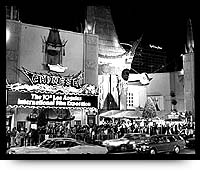
Expanded Cinema, by Gene Youngblood with foreword by R. Buckminister Fuller 1970, in Cybernetic Cinema, The Aesthetics of Machine Language, pages 239-246, http://artscilab.org/expandedcinema/part4.pdf; "John"s spectacular film Cibernetik 5.3 combines computer graphics with organic live-action photography to create a new reality, a Third World Reality, that is both haunting and extraordinarily beautiful. Cybernetik makes use of realist imagery for its nonobjective qualities and thus impinges directly upon the emotions more successfully than any computer film discussed in this book. However, John considers the film only an "incidental test" in an ongoing experiment with computer graphics that has occupied most of his time for the last nine years. John is interested in addressing the computer directly through graphic images rather than using mathematics to achieve graphic images and thus becoming enmeshed in a "number game." Cybernetik is unique also in that it was constructed from semi-random image-generation techniques. Whereas most of the computer films discussed so far are characterized by mathematical precision, Cybernetik exudes a strong feeling for the uncontrolled, the uncontrollable, the unconceivable."
Discussions
with Richard Feynman (California Institute of Technology), presentation
of cybernetic design tools, interactive simulations and genetic design techniques;
time, energy and structural interactions, 1968.

Digital Computer Generated Light Shows and Films: Jimi Hendrix (Saturday
February 10th 1968) a three screen back projection presentation at
the Shrine Auditorium in Los Angeles; also programs with Janis Joplin, The Who,
Grateful Dead, etc. with The Single Wing Turquoise Bird; and in the motion picture
The Baby Maker with Barbara Hershey 1970. http://www.movieline.com/reviews/the_baby_maker.shtml
http://video.barnesandnoble.com/search/product.asp?wrk=3630624
The Montreal World’s Fair EXPO 67 (summer 1967) and presentations with the National Film Board of Canada and experimental animation with Norman McLaren.
Hidden Line
and Surface Rendering Algorithms, UCLA
Boelter Hall Auditorium 3400, 1965. The first demonstration of digital
surface processing techniques, a lecture and multi-screen environmental motion
picture presentations of automated motion picture animation techniques; with
attendance of Chuck Jones of Warner Brothers.
Cibernetik 5.3, 1960-5, the first film applications of: computer
animation, digital production techniques, image processing algorithms, artificial
intelligence,
genetic modeling and biologic pattern formation techniques; first computer
generated motion picture. Presented at: UCLA 1964-5, The Montreal World’s
Fair 1967, The Jimi Hendrix Experience February 1968, The First Los Angeles
International Film Exhibition, Los Angeles County Museum of Art, The Seventh
International Animated Film Exhibition, The European Media Arts Festival
1995, London Film and Video Programme 1997, Barcelona Spain, Hanover Germany
1998, the Whitney Museums retrospective of 20th century art, NY 2000, etc; and
many times more exhibitions than are mentioned here that were never recorded.
Most of the screening information listed here was obtained from recent web
pages that were not
quickly deleted.
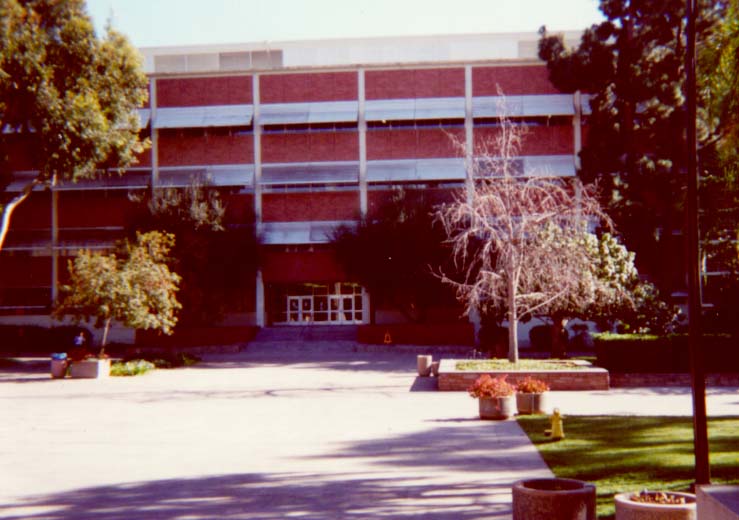
UCLA Boelter Hall, Engineering Department, Los Angeles
Title Cibernetik 5.3
Director John~
Country of origin America
Technique Cybernetic animation
Length 8 minutes
Format 16 mm
Year 1960-65
When invited to participate in the slaughter of four million Vietnamese John felt that if required prison was a preferable alternative; however his father believed that obedience to government authority was always a patriotic duty. At age 17 the matter was quickly resolved by attending universities, with the additional personal intention of inventing something completely new and potentially useful. Within a few days in 1960 John began work on creating a system for computer animation. Related research was begun on theories of image formation, the physics of motion, field effects, mathematical topography, acoustic synthesis, and artificial intelligence, along with cerebral stimulation, deep brain recording techniques, genetic control mechanisms and embryological development. During that time John had originated numerous image processing algorithms to automatically design, transform and render three-dimensional images using genetic and artificial intelligence control mechanisms, which resulted in the first computer motion picture Cibernetik 5.3, (system 5 version 3), which was produced soon after digital film recording became available in 1964.
Most of the next two decades were spent creating natural language controlled meta-systems, which could be used to rapidly originate an unlimited range of motion picture and music environments, in which the computer has the neurological capabilities to become the creative artist. This work was developed long before graphic displays were attached to computers, which made interactive visualization and hand controlled animation practically an impossibility, but encouraged new ways of considering how visions could be originated, and how a machine may also create a vision and put it on film, potentially with dialog, stories and music. While this vision is still far from being fulfilled, Cibernetik 5.3 was the first step toward a cinema where the computer can originate the actors potentially from DNA samples, observe their development, needs, conflicts and aspirations; then see their lives unfold by creating any number of circumstances, scenarios and motion pictures; perhaps eventually based on monitoring our own thoughts and dreams; ultimately offering us alternatives and insights that might help our lives.
At the core of his work, John explores the concept of idea generation – in his case the evolution of graphic visions. “I wanted to see if I could create some semblance of a mind,” he explains. “We may have noticed that our own imagination is frequently limited, usually greatly influenced by our memories, consequently easily anticipated, while machines, when designed to be cognitive, can greatly expand our visions, even our technical understanding and ultimately extend our own personal horizons. Computers offer us a way of interpreting our lives – cybernetics and genetics are simply offering us the tools to explore life and benefit our existence on a very complex level.”
John’s landmark film Cibernetik 5.3 (1960-65) is an abstract, graphic tour de force. It was made on a computer that didn't even have a screen, just punch cards and tape. In order to output the film he took his magnetic tapes from UCLA to General Dynamics in San Diego, where there was a digital film recorder. He was allowed only one chance on their computers to realize his film. For John, the excitement was not knowing what was going to come out of the machine, – had he actually made a film or was it simply going to be unintelligible rubbish? Fortunately for John he had made an animation classic.
John’s film was certainly well timed, coinciding with the growing influence of LSD and psychedelia - he once ran it over three projectors at a Jimi Hendrix concert. For several years after the creation of Cibernetik 5.3, John worked on creating a verbally controlled meta-system that could make the design of advanced computer animation systems an exceptionally simple process. At first he worked on mainframe computers before purchasing a mini-computer in the mid 1970s, in which he included conventional animation techniques along with advanced motion and transformational controls. However Hollywood animation studios were not particularly looking for any new visual capabilities, they preferred to continue with existing techniques by lowering costs through Korean labor, or perhaps just wait a few decades for a system to come along with a long history of commercial screen credits.
According to John, this part of his life was, “so labor intensive that it could have had dangerous health consequences, and so I was relieved to change direction and immediately begin working on environmental and species restoration issues, which are vastly more crucial to our continuity and survival. I saw the need for architectures that would not destroy the environment, industries that are not based on promoting overpopulation, non-toxic sustainable food resources, new biologic techniques to help restore threatened species, an approach to justice that doesn't dominate and devastate human life, and people who have the ability to create cooperative communities to care for our human legacy. Clearly there are now plenty of people being paid to advance computer technology; however comparatively little consideration has ever been offered to find solutions to any of the vastly more significant issues affecting our own lives and nature.”
Although he only made one computer film, John"s contribution to the world of experimental computer animation should not be underestimated. He took it to a place it had never been before or since, and where it is unlikely to venture again perhaps for a very long time.
Cibernetik 5.3 is an abstract tour de force – colors and shapes swirl and bloom to create a truly psychedelic experience.
The details of this work with design notes, motion picture images, along with an exploration of the system design potential for a Cybernetic Cinema is described at: http://www.cyberneticcinema.com/
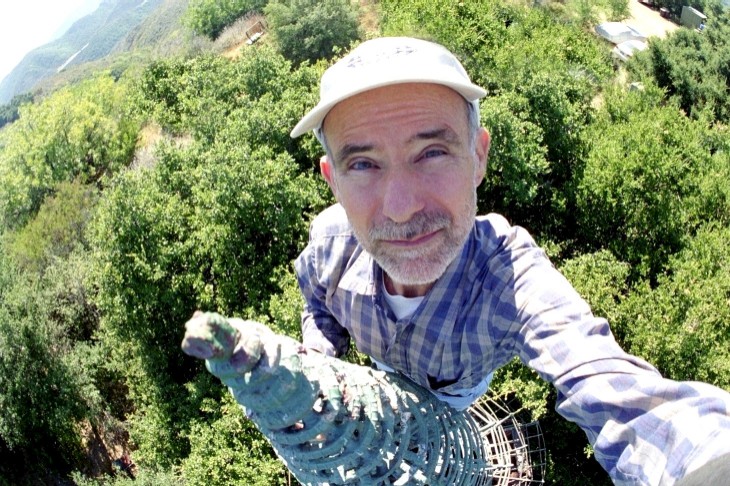
On a spire 15 meters above the first digital animation studio (1970-75); in an oak forest above the Pacific Ocean, Malibu California (180 degree diagonal photo taken July 17, 2001). The idea of the tower was an ultra low-impact architectural solution to working compatibly with nature. Going vertical on a small-scale can have very little impact by touching the ground in a small area, or perhaps on one or a few points perhaps of no more than about 1 square foot each. Although it's not typical and rarely happens; human presence in a wilderness environment can provide the labor that's needed to restore often massive damages inflicted against nature over the centuries, particularly if nearly the income that can be derived from such restoration work and facilities can be used to encourage or pay for extending the protection and care of wilderness elsewhere; allowing for the slow growth of a healing process.
(js, January 16, 2003)
Home Images History Notes Algorithms Presentations
<*John~=1st+last, John"s=1st+last possessive, John=last, John's=last possessive.>
E-mail: E-mail: info@cyberneticcinema.com, Web site: www.cyberneticcinema.com, cyberanimation.tripod.com, © 2003 Cybernetic Cinema, updated Wednesday, May 31, 2006 4:14 PM